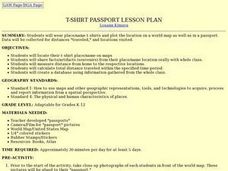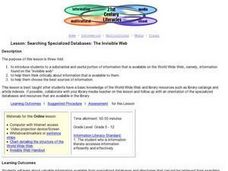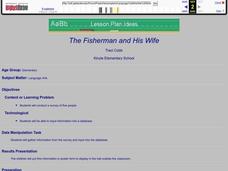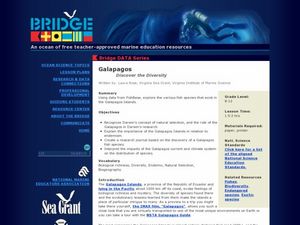Curated OER
Mammals of the Deep Blue
Third graders study ocean mammals. They explore various websites and databases to answer questions and record answers about whales and dolphins. Finally they use the information obtained to write a report about them.
Curated OER
Religious Influence On US History
Eleventh graders explore the influence of religion on U.S. History. Using an internet database website, they research the religious affiliation of governors, Presidents and Vice-Presidents. Students write a paragraph explaining how...
Curated OER
Dinosaurs
Second graders use the internet to find information about dinosaurs. Using the information, they complete a database with where the dinosaurs lived, diet, and where bones were found. To end the lesson, they are given criteria and review...
Curated OER
T-shirt Passport Lesson Plan
Learners locate their t-shirt place/name on maps, then share facts/artifacts (souvenirs) from their place/name location orally with whole class. They create a database using information gathered from the whole class.
Curated OER
Sequences and Series
Students use Excel Database to explore sequences and series. They examine how to calculate term positions and Sigma Notations. Students use Excel to calculate the values and they print the pages for grading.
Curated OER
How to Use the Kentucky Virtual Library
Looking for a way to use the Kentucky Virtual Library (KYVL) in your classroom? Use this presentation to show your students the step-by-step procedure for finding an article on the database. The slideshow would work for secondary grade...
Curated OER
Making a Family Tree
Learners, in groups, produce a family tree using computers to facilitate research and presentation. They plan, discuss and evaluate different technologies used in this assignment.
Curated OER
Mapping Crime
Students use data on break and enter crime incidents to make a map that prompt discussion about the spatial location of crime in the city, why it would occur in those places, and how residents may reduce crime.
Curated OER
Constructivist Theory
Students in a teacher education program are introduced to the constructivist theory. In grade level teams, they take their subject matter focus and create lesson plans related to the constructivist theory. They are graded with a rubric...
Curated OER
Searching Specialized Databases: The Invisible Web
Learners examine the useful information to be found on the "invisible web." They find the best sources of relevant information.
Curated OER
Promote Your Media Center!
Students use a webquest to use Research Process Model (RPM), and the information they gather to prove to everyone what a wonderful and helpful resource the Library/Media Center really is.
Curated OER
And the Survey Says...
Learners use technology to input, retrieve, organize, manipulate, evaluate, and communicate information; apply appropriate technologies to critical thinking, creative expression, and decision-making skills. They collect and explore data...
Curated OER
Design Team Challenge
Students work in groups to build a robot. In this robotics lesson, students create an electronic robot and program it to follow directions. They create an obstacle course for the robot to follow and test its performance.
Curated OER
The Fisherman and His Wife
Young scholars will conduct a survey, using the information collected they will construct a poster.
Curated OER
Sea Changes: A New England Industry
Students conduct research in order to use primary and secondary sources. They interpret and analyze information from textbooks and nonfiction books for young adults, as well as reference materials, audio and media presentations, oral...
Curated OER
Precipitation in Michigan Cities
Third graders investigate the rainfall amounts in four Michigan cities to observe how cities near lakes are affected differently by precipitation than those that are inland. They record the rainfall for the cities over an eight day...
Curated OER
"who Lives in Your House?"
Fourth graders collect data about the people and animals living in their homes, and the students' shoe sizes. They work in groups to enter the information into a database from which they create graphs. They analyze the data to find the...
Curated OER
Tour a Museum
Take your youngsters on a virtual tour of a Spanish museum. Select around 10 works of art to show your class. El Prado museum, in Madrid, has a great online database you can use. Select the works of art beforehand, so you're all set for...
Curated OER
Who is the Sea Otter Related to?
Learners examine the genetic relationships of different organisms. In groups, they discover the importance of genes and how different amino acids show various evolutionary relationships. They use an online database to continue their...
Curated OER
Galapagos - Discover the Diversity
Pretend you are exploring a newly discovered species of fish in the Galapagos. Your budding marine biologists access FishBase Database's list of marine/brackish fishes and choose one to research. The link through this website does not...
Curated OER
Global Warming - The Heat is On: Global Climate Change Revisited
After listening to your lecture on climate change, young scientists access NOAA's database listing Mauna Loa's carbon dioxide data. They graph the monthly means and then compare their graphs to NOAA's. This is a concise plan that could...
Curated OER
Math #3 Problems at the Ballpark
Students examine charts to answer questions. They develop their own database.
Curated OER
Cell Discoveries
Students observe, compare and describe cell organelles in terms of their function, structure and operation. They enter and edit information in a database, build and sort a student-designed database and find records in a database.
Other popular searches
- Databases. Search Engines
- Access Databases
- Microsoft Access Databases
- Creating Databases
- Using Databases
- Creating Access Databases
- Library Databases
- Searching Databases
- Election and Databases
- Learning About Databases
- Databases Lesson
- Appleworks Databases

























